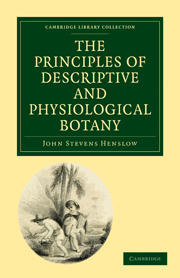Book contents
- Frontmatter
- Contents
- INTRODUCTION
- PART I DESCRIPTIVE BOTANY
- SECTION I ORGANOGRAPHY AND GLOSSOLOGY
- SECTION II TAXONOMY AND PHYTOGRAPHY
- PART II PHYSIOLOGICAL BOTANY
- CHAPTER I VITAL PROPERTIES AND STIMULANTS
- CHAPTER II FUNCTION OF NUTRITION — Periods 1, 2, 3, 4
- CHAPTER III FUNCTION OF NUTRITION — continued — Periods 5, 6
- CHAPTER IV FUNCTION OF NUTRITION — continued — Period 7
- CHAPTER V FUNCTION OF REPRODUCTION — Periods 1, 2, 3
- CHAPTER VI FUNCTION OF REPRODUCTION — continued — Periods 4, 5
- CHAPTER VII EPIRRHEOLOGY, BOTANICAL GEOGRAPHY, FOSSIL BOTANY
- INDEX AND GLOSSARY
CHAPTER V - FUNCTION OF REPRODUCTION — Periods 1, 2, 3
Published online by Cambridge University Press: 05 December 2011
- Frontmatter
- Contents
- INTRODUCTION
- PART I DESCRIPTIVE BOTANY
- SECTION I ORGANOGRAPHY AND GLOSSOLOGY
- SECTION II TAXONOMY AND PHYTOGRAPHY
- PART II PHYSIOLOGICAL BOTANY
- CHAPTER I VITAL PROPERTIES AND STIMULANTS
- CHAPTER II FUNCTION OF NUTRITION — Periods 1, 2, 3, 4
- CHAPTER III FUNCTION OF NUTRITION — continued — Periods 5, 6
- CHAPTER IV FUNCTION OF NUTRITION — continued — Period 7
- CHAPTER V FUNCTION OF REPRODUCTION — Periods 1, 2, 3
- CHAPTER VI FUNCTION OF REPRODUCTION — continued — Periods 4, 5
- CHAPTER VII EPIRRHEOLOGY, BOTANICAL GEOGRAPHY, FOSSIL BOTANY
- INDEX AND GLOSSARY
Summary
(243.) Propagation. — There are two distinct modes, according to which the propagation of the vegetable species is naturally secured, viz. “subdivision” and “reproduction.” In the first the individual plant maybe subdivided into several parts, each of which when detached from the parent stock is capable of existing as a separate individual. A familiar example of this mode of propagation may be seen in the common strawberry, to which we have alluded in art. 237. It is very common to find elms, poplars, and other trees throwing up suckers from their roots at a distance from the trunk, all of which are capable of becoming so many distinct trees, under favourable circumstances. Man has availed himself of this property, to extend the means which nature has provided for the propagation of the species; and by placing cuttings, slips, and buds under proper treatment, he forces them to throw out roots; or he grafts them on other stems, where they adhere and develop as so many separate and independent individuals. The process by which any detached portion of a plant becomes a distinct individual, similar to that from which it was derived, depends upon the power it possesses of reproducing those organs or parts in which it may be defective. Thus the ascending organs develop roots; and these again, produce buds from which the ascending organs proceed.
- Type
- Chapter
- Information
- The Principles of Descriptive and Physiological Botany , pp. 248 - 275Publisher: Cambridge University PressPrint publication year: 2009First published in: 1835

